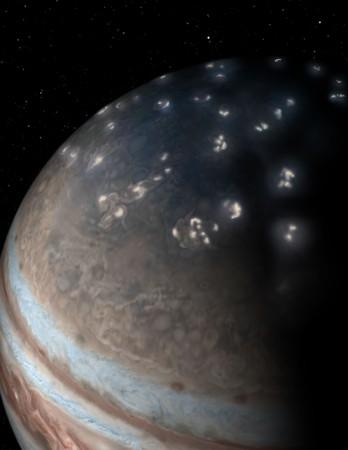
Lightning in Jupiter was first spotted when Voyager 1 made a flyby in 1979 and since then, the phenomena has been a matter of interest for researchers all over the world. Only now, after over 30 years, NASA's Juno mission has sent back enough information about Jovian lightning and it has revealed how it is both similar and quite different from Earth's lightning.
In a release by NASA, the agency explains how Juno, which is right now orbiting the gas giant is using one of its sensitive instruments – Microwave Radiometer Instrument (MWR). It records emissions coming from Jupiter and reads it across a wide spectrum of frequencies.
"No matter what planet you're on, lightning bolts act like radio transmitters – sending out radio waves when they flash across a sky," said Shannon Brown of NASA's Jet Propulsion Laboratory in Pasadena, California, a Juno scientist and lead author of the paper that was also published in the journal Nature.
Brown explained how all the previous probes – Voyagers 1 and 2, Galileo and even Cassini recorded lightning signals, but they were, "limited to either visual detections or from the kilohertz range of the radio spectrum, despite a search for signals in the megahertz range." Several theories were proposed to attempt to explain the phenomenon, but, none worked.
Ever since it reached Jupiter, Juno has made eight flybys so far and has recorded 377 lightning discharges, reported NASA. The bolts were recorded both in the megahertz as well as gigahertz ranges, which is similar to the lightning that is found on Earth, says Brown.
"We think the reason we are the only ones who can see it is because Juno is flying closer to the lighting than ever before, and we are searching at a radio frequency that passes easily through Jupiter's ionosphere," she added.
In a nutshell, what NASA has found is that the lightning on Jupiter is strikingly similar to lightning on Earth in terms of frequency. Having said that, there is a stark difference in where lightning strikes on Earth when compared to Jupiter.
The gas giant's lightning storms appear to be concentrated near the planet's poles with very little electrical activity near the equatorial belt. This, in spite of Jupiter's equator playing host to the solar system's largest, most ferocious storm.
As to why lightning on Jupiter is concentrated near its poles and not at the equator, NASA says that it simply follows heat. On Earth, the tropics, which experiences the most active electric storms is also the region that is most hot, mostly because of solar radiation. Warm and moist air rises to the top freely and fuels lightning storms, notes the report.
Jupiter, on the other hand, receives 25 times less sunlight than the Earth and derives most of its heat from within the planet. This means that even though the poles of Jupiter are actually colder than its equatorial belt, the heat from within the planet tends to drive convection of the lower atmosphere and provides moist, warm air for thunderstorms.
Juno will make flyby number 13 over Jupiter on 16 July this year.














